
We Only Find Them When They’re Dead – 2020-2022 (BOOM! Studios) – Sci-Fi, Action
Author: Al Ewing
Art: Simone Di Meo
Series Contents: We Only Find Them When They’re Dead #1-15
A supremely high-concept Sci-Fi adventure with gorgeous artwork, We Only Find Them When They’re Dead brings a lot to take in, for better or worse. Told in three separate five-issue chapters, the story covers all sorts of wild ideas, like harvesting from dead God beings and new religions born because of them.

Story:
The story is very hard to describe, and what this review covers will really just scratch the surface, but basically, there is an economy based around absolutely enormous “Gods” which appear in space, lifeless. “Autopsy” ships with small crews push it to the limits to harvest from these “God corpses.” This can be parts of their metallic outfits, literal chunks of their flesh, or other Godly bits, and anything useful in any economic market.
Opening the tale is the year 2323 and the Vihaan autopsy shit. A young child Georges Malik flies with his mother’s command, and the Vihaan crew of four. He sees a God. It changes his life forever. Then, quickly it is 2367 and the Vihaan II is crewed by four, however this time Georges leads the ship himself.
The other shipmates include Ella Hauer, the Coroner, Alice Wirth, the Quartermaster, and Jason Hauer, the Engineer. All of them have specific tasks to keep the ship alive and collect their bounties. Just like his mom, Georges is out to harvest from the Gods. They are always beautiful, and they are always dead.
This opening set-up provides nigh infinite possibility and a lot of intrigue. Combine that with absolutely stellar art for a Sci-Fi tale, and you have a shot at making magic. So, how is it all, and where does it all go?
This one is a bit harder to cover, because I really like Al Ewing’s writing, but this one gets a bit convoluted, as well as shifts gears so quickly that it’s relatively hard to keep all things straight. Just when I think I am starting to catch its groove, it is changing again, both in time period and in characters. Plot lines also come and go; however, they are not lost, they just may be picked up again later in a surprising way and also in the far future from when they began.
There is totally a lot of very interesting Sci Fi, thoughts on life, the universe and everything, but there is also a bit of a challenge in navigating exactly what is happening and when. Additional readings may yield additional story rewards, so I will likely give this another pass in the future.
For now, the story is broken up into three five-issue “chapters” which are mostly their own periods of time and build on each other, however also each jump around and cover many characters, time periods and plot angles. I liked more about this whole adventure than I didn’t, but after one reading, I couldn’t help but feel like things were a bit rushed, and some plots went by very quickly. There was so much to explore with the concepts, and I feel like some of it was left untapped.
If you want really inventive Sci-Fi and don’t mind a bit of mess in the storytelling, check this out, it is worth it despite a bit of a rocky road throughout the 15 issues.
Art:
The art is absolutely amazing, and fits the insanity of the tale very well, presenting high-concept Gods and cool ship designs with wonderful detail, and spectacular color. I can’t say enough about how cool it is to look at this tale as it unwinds. The action scenes are exciting and full of movement, but even the most basic scenes of characters talking are glorious to behold visually.
Reasons to Read:
We Only Find Them When They’re Dead will at the very least challenge your brain in a few ways, with one just being a basic undertaking of following the story. There is a lot to be pondered in these quick 15 issues, and the story has plenty of excitement as well as philosophical touches. The art also alone is worth the price of admission, as it is glorious.
Similar Titles:
Godfell; Saga; Planetary; The Many Deaths of Laila Starr; Middlewest; Reborn; Invisible Kingdom; Decorum
